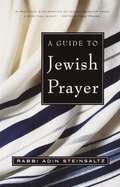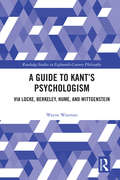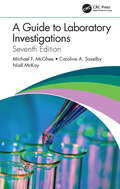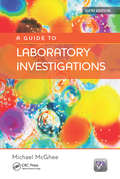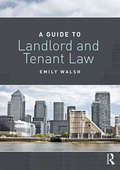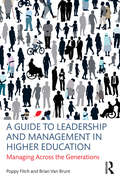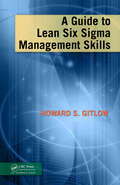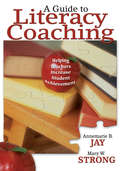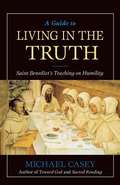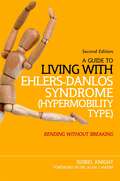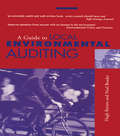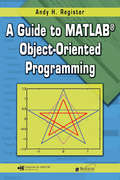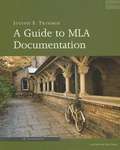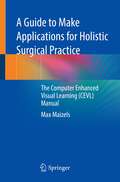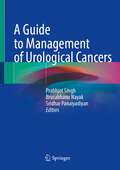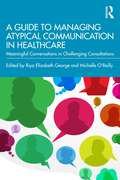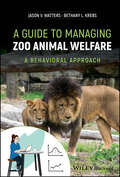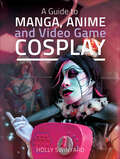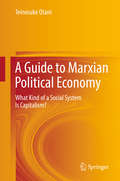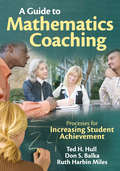- Table View
- List View
A Guide to Jewish Prayer
by Adin SteinsaltzOne of the world's most famous and respected rabbis has given us the one guide we need to practice Jewish prayer and understand the prayer book. From the origins and meaning of prayer to a step-by-step explanation of the daily services to the reason you're not supposed to chat with your friends during the service, Rabbi Adin Steinsaltz answers many of the questions likely to arise about Jewish prayer. Here are chapters on daily prayer; Sabbath prayer; prayer services for the holidays; the yearly cycle of synagogue Bible readings; the history and make-up of the synagogue; the different prayer rites for Ashkenazim, Sephardim, Yemenites, and other cultural/geographic groupings; the role of the rabbi and the cantor in the synagogue; and the role of music in the service. The book also contains a glossary, a bibliography, and biographical sketches of the rabbis who were instrumental in creating and ordering the prayers through the ages. Rabbi Steinsaltz's guide is an essential volume both for the newcomer to Jewish prayer and for those who have been engaged in prayer for years. From the Hardcover edition.
A Guide to Kant’s Psychologism: via Locke, Berkeley, Hume, and Wittgenstein (Routledge Studies in Eighteenth-Century Philosophy)
by Wayne WaxmanThis book presents an interpretation of Kant’s Critique of Pure Reason as a priori psychologism. It groups Kant’s philosophy together with those of the British empiricists—Locke, Berkeley, and Hume—in a single line of psychologistic succession and offers a clear explanation of how Kant’s psychologism differs from psychology and idealism. The book reconciles Kant’s philosophy with subsequent developments in science and mathematics, including post-Fregean mathematical logic, non-Euclidean geometry, and both relativity and quantum theory. It also relates Kant’s psychologism to Wittgenstein’s later conception of language. Finally, the author reveals the ways in which Kant’s philosophy dovetails with contemporary scientific theorizing about the natural phenomenon of consciousness and its place in nature. This book will be of interest to Kant scholars and historians of philosophy working on the British empiricists.
A Guide to Laboratory Investigations
by Michael F. McGhee Caroline A. Saxelby Niall McKayThe seventh edition of this concise, highly practical guide to the interpretation of normal and abnormal laboratory results is fully revised and expanded, with updates on established and familiar tests, as well as interpretations on recent developments.With increasing responsibility being placed on primary care, the book includes guidelines on specific clinical conditions such as heart failure, management of female infertility, specific lipid monitoring in diabetes and guidance for monitoring renal failure. It also includes suggestions for appropriate laboratory tests in certain clinical situations, for example: dementia screen, screening tests when a patient presents with a neuropathy, and appropriate tests for patients presenting with hypertension, chronic fatigue syndrome, erectile dysfunction and gynaecomastia. Completely up-to-date, A Guide to Laboratory Investigations, Seventh Edition remains an essential handbook for all primary care professionals professionals and a valuable reference for medical students and hospital physicians in training and in practice.
A Guide to Laboratory Investigations, 6th Edition
by Mike McGheeThis concise, highly practical guide to the interpretation of normal and abnormal laboratory results is now fully revised and expanded, with updates on established and familiar tests, as well as interpretations on recent developments.With increasing responsibility being placed on primary care, this new edition presents guidelines on specific clinical conditions such as heart failure, management of female infertility, specific lipid monitoring in diabetes and guidance for monitoring renal failure. It also includes suggestions for appropriate laboratory tests in certain clinical situations, for example: dementia screen, screening tests when a patient presents with a neuropathy, and appropriate tests for patients presenting with hypertension, chronic fatigue syndrome, erectile dysfunction and gynaecomastia. Completely up-to-date, A Guide to Laboratory Investigations, Sixth Edition remains an essential reference for all healthcare professionals.
A Guide to Landlord and Tenant Law
by Emily WalshA Guide to Landlord and Tenant Law provides a strong foundation in commercial landlord and tenant, and housing law. The book is designed to provide a complete course text for both undergraduate and postgraduate students from surveying and real estate management backgrounds. This clear and accessible textbook aims to introduce the reader to the fundamentals of both residential and commercial landlord and tenant law by considering the nature of the tenancy and the relationship between the parties. It examines the main elements of the commercial lease including rent, repair, alienation, termination and statutory renewal. The main types of residential tenancy are also considered including: assured and assured shorthold tenancies, secure and Rent Act tenancies and long leasehold enfranchisement. The book aims to familiarise the reader with the contractual documentation as well as the common law and statutory codes which form the basis of landlord and tenant transactions. It contains useful features such as: extracts from the Model Commercial Lease key case summaries, a glossary and chapter summaries further reading lists In addition, students on the Legal Practice Course and Bar Professional Training Course will find this to be a useful supplementary resource as will professional surveyors and lawyers looking for a refresher on the latest landlord and tenant law.
A Guide to Latin Elegy and Lyric (Blackwell Guides to Classical Literature)
by Barbara K. Gold Genevieve LiveleyProvides the necessary context to read elegiac and lyric poetry, designed for novice and experienced Classics and Latin students alike A Guide to Latin Elegy and Lyric explores the language of Latin poetry while helping readers understand the socio-cultural context of the remarkable period of Roman literary history in which the poetry was composed. With an innovative approach to this important area of classical scholarship, the authors treat elegy alongside lyric as they cover topics such as the Hellenistic influences on Augustan poetry, the key figures that shaped the elegiac tradition of Rome, the motifs of militia amoris ("the warfare of love") and servitium amoris (“the slavery of love”) in Latin love elegy, and more. Organized into ten chapters, the book begins with an introduction to the literary, political, and social contexts of the Augustan Age. The next six chapters each focus on an individual lyric and elegiac poet—Catullus, Horace, Tibullus, Propertius, Ovid, and Sulpicia—followed by a survey of several lesser-known poets and post-Augustan elegy and lyric. The text concludes with a discussion of major tropes and themes in Latin elegy and lyric, and an overview and analysis of key critical approaches in current scholarship. This volume: Includes full translations alongside the Latin throughout the text to illustrate discussions Analyzes recurring themes and tropes found in Latin poetry such as sexuality and gender, politics and patronage, myth and religion, wealth and poverty, empire, madness, magic, and witchcraft Reviews modern critical approaches to elegiac and lyric poetry including autobiographical realism, psychoanalysis, narratology, reception, and decolonization Includes helpful introductory sections: "How to Read a Latin Elegiac or Lyric Poem" and "How to Teach a Latin Elegiac and Lyric Poem" Provides information about each poet, an in-depth discussion of some of their poetry, and cultural and historical background Features a dedicated chapter on Sulpicia, offering readers an ancient female viewpoint on sex and gender, politics, and patronage Part of the acclaimed Blackwell Guides to Classical Literature series, A Guide to Latin Elegy and Lyric is the perfect text for both introductory and advanced courses in Latin elegy and lyric, accessible for students reading the poetry in translation, as well as for those experienced in Latin with an interest in learning a different approach to the subject.
A Guide to Leadership and Management in Higher Education: Managing Across the Generations
by Brian Van Brunt Poppy FitchA Guide to Leadership and Management in Higher Education shares an innovative approach to supervision, leadership, and management in the higher education workplace. Drawing from humanism and positive psychology, Fitch and Van Brunt weave together a compelling narrative for managing employees across generational differences. This book shares key leadership lessons and advice on how to inspire creativity, increase efficiency, and tap into the talents of your diverse, multi-generational staff. This guide offers practical and detailed advice on establishing new relationships, setting expectations, encouraging accountability, addressing conflict, and supervising difficult staff. Focusing on how to build and strengthen connections through genuineness and empathic caring, this book provides important guidance for today’s college and university leaders.
A Guide to Lean Six Sigma Management Skills
by Howard S GitlowIn summary, the purpose of Six Sigma management is topromote joy in work for all employees so that they have the energy to participate in the improvement and innovation projects identified from the organizational dashboard! Authored by Dr. Howard Gitlow, one of the most respected Six Sigma Master Black Belts, this well-organized volume demonstrates the implementation of quality improvements into all areas of the workplace from the shop floor through a company‘s executive offices. Illustrating his points with a number of case studies, theauthor provides a compelling argument as to why Six Sigma should be the preferred approach. The book explains how to build an organization that encourages and values the input of quality teams detailing the steps required to implement and maintain lean initiatives.
A Guide to Literacy Coaching: Helping Teachers Increase Student Achievement
by Annemarie B. Jay Mary W. StrongThis practical guide presents effective coaching strategies and best practices for enhancing literacy instruction, working with administrators and communities, and boosting student performance across all grade levels.
A Guide to Living in the Truth: Saint Benedict's Teaching on Humility
by Michael CaseyThis is a beautifully written devotional book for those who want a better understanding of the Biblical intentions of humility. It also explores Saint Benedict's encouragement of all religious disciples to practice the Christlike characteristic.
A Guide to Living with Ehlers-Danlos Syndrome (Hypermobility Type): Bending without Breaking (2nd edition)
by Isobel Knight Alan HakimCovering everything from recognising symptoms and obtaining initial diagnosis to living with the condition on a daily basis, this complete guide to living with and managing Ehlers-Danlos Syndrome (Hypermobility Type - formerly known as Type III) has been revised and fully-updated in this accessible new edition. The author, who has the condition, looks at how it affects children and adolescents and explores pain management, pregnancy, physical and psychological aspects, and how it widely affects dancers and other performance artists. New material includes: changes in terminology information on how osteopathy and nutrition can help psychological approaches beyond CBT how to deal with professionals what to expect from support groups and rehabilitation programmes This new edition will be a must for anybody who suffers, or suspects they might be suffering from, Ehlers-Danlos Syndrome (Hypermobility Type) and provides everything needed to enjoy a fulfilling life with this complex condition. It will also be of interest to their families and friends, and professionals working with Hypermobility Type EDS.
A Guide to Local Environmental Auditing
by Hugh Barton Noel BruderSustainable development is still seen by authorities as an abstract concept. Local Environmental Auditing will help put it into practice. The book provides a comprehensive guide to monitoring the state of the local environment and establishing the impacts of local actions on global issues, and shows how current local authority policy and practice can be adapted to recognize environmental priorities. The authors provide both a guide to and an assessment of the subject: they link the processes with the issues, with specific information on carrying out the audit (including checklists, case studies and standards) and a detailed discussion of the issues and choices which local authorities may face. Clearly structured and accessible, this will be an essential handbook, both for local government departments and other local organizations, and students in a wide range of subjects, including environmental science and health, town planning, urban and rural studies, social science and politics.
A Guide to MATLAB Object-Oriented Programming
by Andy H. RegisterA Guide to MATLAB Object-Oriented Programming is the first book to deliver broad coverage of the documented and undocumented object-oriented features of MATLAB. Unlike the typical approach of other resources, this guide explains why each feature is important, demonstrates how each feature is used, and promotes an understanding of
A Guide to MATLAB®
by Brian R. Hunt Ronald L. Lipsman Jonathan M. RosenbergThis book is a short, focused introduction to MATLAB, a comprehensive software system for mathematics and technical computing. It should be useful to both beginning and experienced users. It contains concise explanations of essential MATLAB commands, as well as easily understood instructions for using MATLAB's programming features, graphical capabilities, and desktop interface. It also includes an introduction to SIMULINK, a companion to MATLAB for system simulation. Written for MATLAB 6, this book can also be used with earlier (and later) versions of MATLAB. This book contains worked-out examples of applications of MATLAB to interesting problems in mathematics, engineering, economics, and physics. In addition, it contains explicit instructions for using MATLAB's Microsoft Word interface to produce polished, integrated, interactive documents for reports, presentations, or on-line publishing. This book explains everything you need to know to begin using MATLAB to do all these things and more. Intermediate and advanced users will find useful information here, especially if they are making the switch to MATLAB 6 from an earlier version.
A Guide to MATLAB® for Beginners and Experienced Users
by Brian R. Hunt Ronald L. Lipsman Jonathan M. RosenbergHere is a short, focused introduction to MATLAB, a comprehensive software system for mathematics and technical computing that should be useful to both beginning and experienced users. It contains concise explanations of essential MATLAB commands, as well as easily understood instructions for using MATLAB's programming features, graphical capabilities, and desktop interface. It also includes an introduction to SIMULINK, a companion to MATLAB for system simulation. Written for MATLAB 6, this book can also be used with earlier (and later) versions of MATLAB. Chapters contain worked-out examples of applications of MATLAB to interesting problems in mathematics, engineering, economics, and physics. In addition, it contains explicit instructions for using MATLAB's Microsoft Word interface to produce polished, integrated, interactive documents for reports, presentations, or on-line publishing. This book explains everything you need to know to begin using MATLAB. Intermediate and advanced users will find useful information here, especially if they are making the switch to MATLAB 6 from an earlier version.
A Guide to MLA Documentation with an Appendix on APA Style
by Joseph F. TrimmerBriefer, cheaper, and easier to use than the MLA's own handbook, this popular booklet features current MLA guidelines, a new section on evaluating online sources, and an up-to-date APA appendix. The guide also provides numerous examples, a sample research paper, and helpful hints on such topics as avoiding plagiarism and taking notes.
A Guide to MLA Documentation: with an Appendix on APA Style
by Joseph F. TrimmerBriefer, more affordable, and easier to use than the MLA's own handbook, this popular booklet features current MLA guidelines, a new section on evaluating online sources, and an up-to-date APA appendix. The guide also provides numerous examples, a sample research paper, and helpful hints on such topics as avoiding plagiarism and taking notes.
A Guide to Magical Mystical Sites: Europe and the British Isles
by Elizabeth Pepper John Wilcock"Ephesus, Delhi, Malta, the Basque country, Chartres, Stonehenge . . . this is the real magical mystery tour. "Wilcock and Pepper provide more historical background than any tour guide could relate, plus information to keep the mystery in the atmosphere, and not in your travel arrangements. "They cover not only the main attraction, but also lesser known places of enchantment nearby. "Best of all, Wilcock and Pepper manage to capture the feeling of being there, the sense of the magic and mystery of so many centuries."
A Guide to Make Applications for Holistic Surgical Practice: The Computer Enhanced Visual Learning (CEVL) Manual
by Max MaizelsThis book aims to enable healthcare workers in creating online learning tools for their specific surgical procedures. Providing an e-learning base by which healthcare workers can create customized procedural training materials, this book empowers practitioners to instruct their staff both within and across specific institutions or surgical areas. Supplying surgical leads with the tools required to inform their team members of what they need to know, what they will be expected to do, and when they will be expected to do it, the methods put forth in this book assist healthcare teams in working more closely and efficiently. Using the techniques this text describes, staff surgeons will be able to streamline their surgeries and support each of their staff members to perform their best. Focused on pediatric urological healthcare workers, each chapter demonstrates real-world applications for the development of codified training procedures. Supplemented with downloadable files for customization, the principles presented in this book apply to diverse specialties including but not limited to urology, orthopedics, obstetrics, and ophthalmology. A Guide to Make Applications for Holistic Surgical Practice: The Computer Enhanced Visual Learning (CEVL) Manual emphasizes practical approaches to the development of training methods for the codification of procedure performance within or across specific institutions or surgical leads.
A Guide to Management of Urological Cancers
by Prabhjot Singh Brusabhanu Nayak Sridhar PanaiyadiyanThe book provides comprehensive review of common uro-oncology cases mainly focusing on its management aspect. It includes diagnosis and clinical staging, surgical management, pathological staging, adjuvant treatment and follow up. It provides current evidence-based approaches for the management of common urological malignancies. All the chapters are written uniformly in a simple yet informative manner by experts in their respective fields. It contains well-prepared illustrations, relevant clinical images and flowcharts. The book is helpful for practicing urologists, uro-oncologists, oncologists as well as urology trainees, uro-oncology fellows in providing a holistic approach to cancer patients. It helps them to develop critical thinking and encourage discussion toward improving the overall care of the patients.
A Guide to Managing Atypical Communication in Healthcare: Meaningful Conversations in Challenging Consultations
by Michelle O’Reilly Riya Elizabeth GeorgeThis book presents a supportive and practical guide for healthcare professionals and trainees in a way that considers a wide spectrum of atypical communication conditions, their impact on everyday healthcare interactions, and the social and cultural contexts in which interactions with atypical communicators take place. A growing number of patients have been reporting atypical capacity for communication, creating unique challenges for healthcare professionals and patients in forming meaningful clinical interactions. In this book, leading international scholars from a range of healthcare professions provide insight into optimal management for those with atypical communication conditions. This includes speech, language, and hearing impairments. Chapters provide optimal management strategies, case examples, clinical recommendations, and recommended resources relevant for a range of healthcare professionals. The first collection of its kind, this book supports inter-professional practices and serves as a useful guide for those with an interest in clinical communication, and communication and diversity. This book will be a valuable resource for health and mental healthcare professionals as well as undergraduate and postgraduate students in healthcare and allied healthcare courses. It can be included as recommended reading material in clinical communication curricula.
A Guide to Managing Zoo Animal Welfare: A Behavioral Approach
by Jason V. Watters Bethany L. KrebsComprehensive reference detailing behavioral assessment techniques, behavioral approaches, and practical tools for animal welfare across different species A Guide to Managing Zoo Animal Welfare delivers a step-by-step guide to behavioral assessment approaches, techniques, and tools for animal welfare with an emphasis on animals living in zoos and aquaria. The authors develop a unique “balance-based” approach that can be used to assess and enhance the welfare of a diverse range of species. Backed by extensive scientific literature, this book also provides foundational context to help readers to understand why the authors give these recommendations and guidelines. This book is divided into three sections. Section I details background concepts and goals, discussing the animal mind through neuroscience, psychology, and behavior, even questioning wild animal behavior’s validity as a template for captive animal behavior. Section II details the core behavioral Needs of animals, investigating, acquiring rewards, and exerting control. Section III explains how to practically assess if animals’ Needs are met and address deficiencies, covering topics like food, space, and social rewards and methods to make environments dynamic. A Guide to Managing Zoo Animal Welfare includes information on: Proximate and ultimate reasoning for the existence of each of the NeedsWelfare benefits of meeting the Needs, including positive affect, maintaining homeostasis, passing on genes, and learning through reinforcementThe highly variable personalities of individual animals and different animal species, as well as why personality is an important facet of animal welfareA guide for assessing animal welfare using the Three Needs model Presenting highly unique insight and a novel approach, A Guide to Managing Zoo Animal Welfare is an essential learning resource for professional animal behaviorists in zoos and aquaria, researchers in animal behavior and animal welfare, and students in veterinary sciences and zoology programs of study.
A Guide to Manga, Anime and Video Game Cosplay
by Holly SwinyardDo you find yourself sat at home wishing you could be in your favorite video game? Or dream of a time when you pretended you were Sailor Moon? Or do you want to embody your Dungeons and Dragons character for real? What’s holding you back? Maybe you need to introduced to cosplay! Cosplay is a phenomenon that is taking over the world. If you haven’t seen it yet, have you not been looking at social media? Cosplay is a mix of exciting craft skills, heady escapism and passion for pop culture that lets you be whoever you want, whenever you want. Cosplay has made its way into TV shows and documentaries, been included as part of film premieres and video game launches, it’s even referenced in the comics, manga and media it comes from! Talk about meta. But what is this super popular hobby? Well, pick up this book, and it’s twin A Guide to Movie and TV Cosplay, to get all the answers. Because it’s more than just dressing up, promise. With a little bit of help from this handy, dandy guide to cosplay, you can get stuck in. Learn about the history of the hobby (it’s been around longer than you’d think!), where it came from and how it got to be the way it is now, get your head around making and designing costumes, find out how about all the amazing skills people are using to make these costumes, and perhaps even try a few yourself. Who knows, you might be rocking out as Astro Boy, Chris Redfield or All Might at the next big comic con! So why not give it a try and play make believe for a day.
A Guide to Marxian Political Economy: What Kind Of A Social System Is Capitalism?
by Teinosuke OtaniThis textbook offers a comprehensive guide to the systematic structure of capitalism, while at the same time introducing readers to all three volumes of Marx’s Capital. Based on his extensive expertise on Marx’s critique of political economy, the author reveals the specific structure of production in capitalist societies and explicates what sets this system apart from other modes of production. Marx’s political economy is explained in a systematic and easy-to-understand manner, using numerous illustrative diagrams to complement the text. This textbook will appeal to all students and scholars looking for a more comprehensive, systematic and theoretical explanation of capitalism, equipping them with a solid theoretical understanding of its core structure.
A Guide to Mathematics Coaching: Processes for Increasing Student Achievement
by Don S. Balka Ted H. Hull Ruth Harbin MilesDiscover how effective coaching relationships add up to improved mathematics teaching and learning! Based on principles established by NCTM and NCSM, this resource outlines a coaching process for engaging math teachers and fostering productive collaborations that lead to better teaching practice and increased student achievement. Focusing on the role of the math coach in transforming mathematics classrooms and ensuring equity, the chapters help coaches: Collaborate with teachers to align and implement curriculum Build trust and rapport with hesitant or resistant teachers Develop collegial partnerships for planning, analyzing, and reflecting on instruction Support and sustain individual and institutional change
